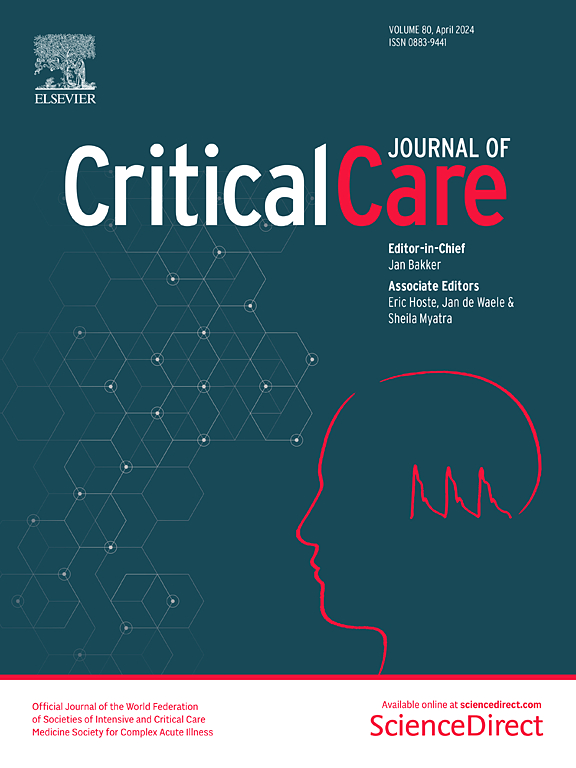Trendelenburg position is a reasonable alternative to passive leg raising for predicting volume responsiveness in mechanically ventilated patients in the ICU
IF 8.8
1区 医学
Q1 CRITICAL CARE MEDICINE
引用次数: 0
Abstract
Passive leg raising (PLR) is a well-recognized method for assessing volume responsiveness in the intensive care unit (ICU); however, it has some limitations. The physiology of the cardiac preload induced by the Trendelenburg position and PLR is similar. The Trendelenburg position can be initiated from the supine position and then tilted downward (TRENDSUPINE) or from the reverse Trendelenburg position and then tilted further downward (TRENDrTREND). Therefore, this study aimed to compare the predictive performance of the percentage change in stroke volume index (ΔSVI) induced by TRENDSUPINE, TRENDrTREND, and PLR for volume responsiveness in mechanically ventilated patients in the ICU. The study was a prospective single-center cohort study conducted in a comprehensive ICU. The study consisted of the following sequential steps: (1) baseline-1: supine position with a 0° bed angulation; (2) Trendelenburg position: 15° downward bed angulation; (3) baseline-2: the same position as baseline-1; (4) reverse Trendelenburg position: 15° upward bed angulation; (5) Trendelenburg position: 15° downward bed angulation; (6) baseline-3: the same position as baseline-1; (7) semi-recumbent position: trunk elevated at 45°; (8) PLR: lower limbs elevated at 45° and trunk in the supine position; (9) baseline-4: the same position as baseline-1; (10) volume loading test: 250 ml of 4% albumin was infused over 10 min. At each time point, hemodynamic parameters were monitored using pulse contour analysis. A positive volume response was defined as an increase of at least 15% in SVI on pulse contour monitoring from baseline-4 after the volume loading test. The receiver operating characteristic curves were performed for ΔSVI. In this study, 36 patients were included for analysis, and of these, 15 patients (42%) were volume-responsive. TRENDSUPINE-induced ΔSVI (ΔSVISUPINE-TREND), TRENDrTREND-induced ΔSVI (ΔSVIrTREND-TREND) and PLR-induced ΔSVI (ΔSVIPLR) were 6%, 16%, and 11%, respectively (ΔSVISUPINE-TREND vs. ΔSVIrSUPINE-TREND, p < 0.001; ΔSVISUPINE-TREND vs. ΔSVIPLR, p < 0.05). The R2 values of the linear regression between ΔSVISUPINE-TREND, ΔSVIrTREND-TREND, ΔSVIPLR and volume loading test-induced ΔSVI were 0.14, 0.32, and 0.43, respectively (all p < 0.001). Furthermore, the area under the receiver operating characteristic curve for predicting volume responsiveness was 0.78 [95% confidence interval (CI), 0.59–0.92], 0.88 (95%CI, 0.75–0.96), and 0.83 (95%CI, 0.61–0.95) for TRENDSUPINE, TRENDrTREND, and PLR-induced ΔSVI, respectively, with no statistically significant difference among them. The sensitivity and specificity for predicting volume responsiveness were 93% and 67% for ΔSVISUPINE-TREND at 4% cutoff, 87% and 76% for ΔSVIrTREND-TREND at 13% cutoff, and 73% and 86% for ΔSVIPLR at 11% cutoff. The Trendelenburg position (TRENDSUPINE and TRENDrTREND)-induced and PLR-induced percentage changes in SVI were similar in their ability to predict volume responsiveness in mechanically ventilated patients in the ICU. Considering that TRENDrTREND induced greater percentage changes in SVI, it is preferentially recommended as a reasonable alternative to PLR for predicting volume responsiveness in certain clinical scenarios. Trial registration: ChiCTR2300067694. Registered on January 18, 2023.求助全文
约1分钟内获得全文
求助全文
来源期刊

Critical Care
医学-危重病医学
CiteScore
20.60
自引率
3.30%
发文量
348
审稿时长
1.5 months
期刊介绍:
Critical Care is an esteemed international medical journal that undergoes a rigorous peer-review process to maintain its high quality standards. Its primary objective is to enhance the healthcare services offered to critically ill patients. To achieve this, the journal focuses on gathering, exchanging, disseminating, and endorsing evidence-based information that is highly relevant to intensivists. By doing so, Critical Care seeks to provide a thorough and inclusive examination of the intensive care field.
 求助内容:
求助内容: 应助结果提醒方式:
应助结果提醒方式:


